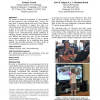Free Online Productivity Tools
i2Speak
i2Symbol
i2OCR
iTex2Img
iWeb2Print
iWeb2Shot
i2Type
iPdf2Split
iPdf2Merge
i2Bopomofo
i2Arabic
i2Style
i2Image
i2PDF
iLatex2Rtf
Sci2ools
CHI
2010
ACM
2010
ACM
Video playdate: toward free play across distance
We present an empirical investigation of video-mediated free play between 13 pairs of friends (ages 7 and 8). The pairs spent 10 minutes playing with each of four different prototypes we developed to support free play over videoconferencing. We coded each interaction for the types of play and the amount of social play observed. The children in our study were largely successful in playing together across videoconferencing, though challenges in managing visibility, attention, and intersubjectivity made it more difficult than face-to-face play. We also found that our prototypes supported some types of play to varying degrees. Our contribution lies in identifying these design tradeoffs and providing directions for future design of video-mediated communication systems for children. Author Keywords Children, free play, CMC, videoconferencing ACM Classification Keywords H5.3. Information interfaces and presentation: Group and Organization Interfaces: Synchronous interaction. General Terms Hu...
| Added | 17 May 2010 |
| Updated | 17 May 2010 |
| Type | Conference |
| Year | 2010 |
| Where | CHI |
| Authors | Svetlana Yarosh, Kori M. Inkpen, A. J. Bernheim Brush |
Comments (0)

